
The insects of the beetle family Chrysomelidae are commonly known as leaf beetles, and include over 37,000 species in more than 2,500 genera, making up one of the largest and most commonly encountered of all beetle families. Numerous subfamilies are recognized, but the precise taxonomy and systematics are likely to change with ongoing research.

The cereal leaf beetle is a significant crop pest, described by Carl Linnaeus in 1758.

Neochlamisus is a genus of leaf beetles in the tribe Fulcidacini. They are members of the case-bearing leaf beetle group, the Camptosomata. Measuring 3–4 millimeters in length as adults, they are cryptic, superficially resembling caterpillar frass. Seventeen, sometimes 18 species are presently accepted in this genus, all of them occurring in North America.

The Chrysomelinae are a subfamily of leaf beetles (Chrysomelidae), commonly known as broad-bodied leaf beetles or broad-shouldered leaf beetles. It includes some 3,000 species around the world.

The Fulcidacini, sometimes known as the warty leaf beetles, are a tribe within the leaf beetle subfamily Cryptocephalinae, though historically they were often treated as a distinct subfamily, Chlamisinae. 11 genera with altogether about 400 species are currently placed here; some four-fifths of the species are found in the Neotropics, but the rest is distributed over all other continents except Antarctica.

The Cryptocephalinae are a subfamily of the leaf beetles (Chrysomelidae), and belong to the group of case-bearing leaf beetles called the Camptosomata. The cases are made from the feces of larvae, passed from one instar to the next, and ultimately serves as a pupation chamber.
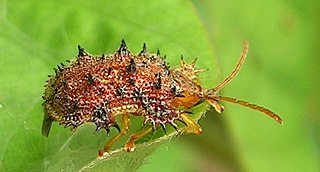
The Cassidinae are a subfamily of the leaf beetles, or Chrysomelidae. The antennae arise close to each other and some members have the pronotal and elytral edges extended to the side and covering the legs so as to give them the common name of tortoise beetles. Some members, such as in the tribe Hispini, are notable for the spiny outgrowths to the pronotum and elytra.

Charidotella sexpunctata, the golden tortoise beetle, is a species of beetle in the leaf beetle family, Chrysomelidae. It is native to the Americas, and very broadly distributed. Charidotella sexpunctata was formerly known as Metriona bicolor. The species has also been seen in regions reaching up to Argentina.
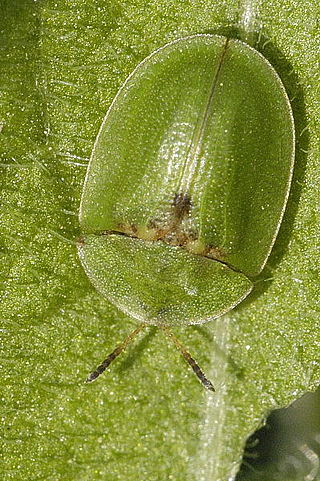
The thistle tortoise beetle is a species of beetle in the subfamily Cassidinae and the genus Cassida. The thistle tortoise beetle can be recognized by its green, rounded back and it can be found on thistle plants in many regions of North America and Europe. The thistle tortioise beetle was first discovered in 1902 in Lévis, Quebec. In 1931, Nellie F. Paterson was the first to document the mature larva. Later, the instar larva of this species was first recorded in 2004 by Jolanta Świętojańska. The thistle tortoise beetle exhibits multiple defense behaviors, such as a flexible shield, providing a barrier against the mandibles of predators, and an excretion that protects the eggs as well.

Labidostomis longimana is a species of short-horned leaf beetles belonging to the family Chrysomelidae, subfamily Cryptocephalinae, tribe Clytrini.

The sumac flea beetle, Blepharida rhois, is most commonly found in North America and is a member of the herbivorous beetle family, Chrysomelidae. More specifically, this beetle is part of the Alticinae subfamily, a highly diverse subfamily that includes more than 1000 species in 550 genera. Members of the Chrysomelidae family are distinguished by their enlarged metafemora and their ability to jump up to 100 times their length. This gives the beetle the ability to catapult jump in order to escape approaching predators. This ability has led to the common name of “flea beetle.” Both larvae and adults are typically a quarter of an inch long. While adults are cream colored with irregular reddish patterns, larvae are typically gray with yellow stripes.
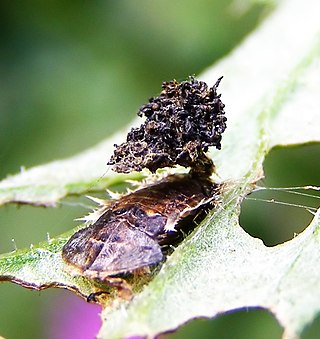
The fecal shield is a structure formed by the larvae of many species of beetles in the leaf beetle family, Chrysomelidae. It is composed of the frass of the insect and often its exuviae, or bits of shed exoskeleton. The beetle may carry the shield on its back or wield it upon its posterior end. The main function of the fecal shield is defense against predators. Other terms for the fecal shield noted in the literature include "larval clothing", "kotanhang", "faecal mask", "faecal pad", and "exuvio-faecal annex".
Neochlamisus gibbosus is a species of warty leaf beetle in the family Chrysomelidae. It is found in Central America and North America. Biology and morphology of all life stages of this species have been described from field study of live populations on Rubus laudatus Berger (Rosaceae) in Kansas. They lay one egg at a time. Females will cover the egg in frass, making a bell-shaped covering for the egg. Larvae will also create cases to attach their body to the host plant when molting. When threatened, they will release a yellow liquid.

Hemisphaerota cyanea, also known as the Palmetto tortoise beetle, is a species in the Chrysomelidae family. Beetles in this family are commonly characterized by their small size, relatively oval and convex shape, variable color but often shining/ iridescent bodies, small heads, and 5-jointed tarsi. Other names include the Florida tortoise beetle and iridescent blue chrysomelid beetle. It is native to the southeastern United States. The specific name (cyanea) means "dark blue," and the beetle earned its name as the palmetto tortoise beetle because it is the only tortoise beetle that feeds on palms.
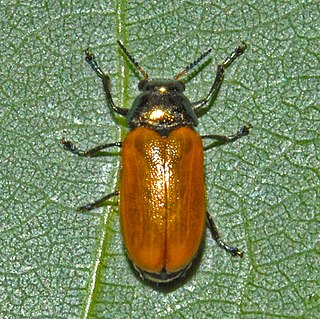
Labidostomis cyanicornis is a species of short-horned leaf beetles belonging to the family Chrysomelidae, subfamily Cryptocephalinae, tribe Clytrini.
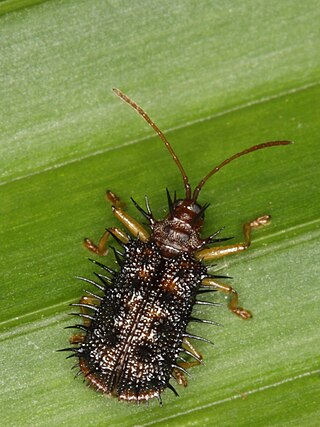
Dicladispa armigera is a species of leaf beetle from Southeast Asia, often known by its common name: the "rice hispa". These beetles are a well known invasive pest, and are responsible for significant crop damage across many countries. The male to female ratio is between 1:1.26 and 1:1.46.

Epistictina reicheana, is a species of leaf beetle found in India, Nepal, Sri Lanka and Tasmania.
Laccoptera (Laccopteroidea) quatuordecimnotata, is a species of leaf beetle native to India, and Sri Lanka.
Silana farinosa, commonly known as curry-leaf tortoise beetle, is a species of leaf beetle native to Indo-China, India, Sri Lanka, Thailand and introduced to Peninsular Malaysia.

Mylassa is a genus of case-bearing leaf beetles in the family Chrysomelidae. It is the only member of the tribe Mylassini within the subfamily Cryptocephalinae. There are seven or eight described species distributed in the southern part of South America.



















